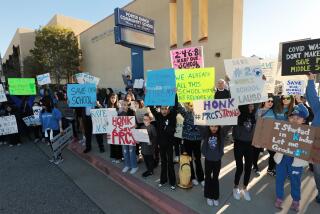Changing Times
- Share via
VAN NUYS — It was 1963. John F. Kennedy was president. Betty Friedan had recently published “The Feminine Mystique,” igniting the modern feminist movement. And in a vacant lot in Van Nuys containing three rundown bungalows, three homemakers opened a school where women could learn without the pressures of academia.
“It was like a bridge from being in the house to being out in the world again,” said Chris Edwards, 67, a co-founder of Everywoman’s Village, which became a model for the changing face of women’s education.
Fast forward to 1999. Many institutions--from university extension programs to local YMCAs--offer women paths to career or personal advancement. And despite the growing competition, Village administrators have continued to follow the independent route so proudly pioneered 36 years ago, relying on student fees to pay the bills.
But after subsidizing its deficits for several years by selling parcels of the original property, the nonprofit school’s board of directors recently announced it would close in November unless enough money can be raised to cover an anticipated $80,000 deficit.
A 300-student boost in enrollment could wipe out the deficit, but that appears unlikely, officials said.
Instead, their last hope seems to lie in finding a corporate or individual sponsor. Executive Director Laura Selwyn, daughter of another co-founder, the late Lynn Selwyn, said she would send a letter within the week to Mayor Richard Riordan seeking help: “I’m hoping people at that level will know of high-level contributors who can step forward.”
*
Edwards and Lynn Selwyn--her sister--and friend Diane Rosner brainstormed the idea for a school where they could learn without having to compete with younger students or professionals. At the time, Selwyn was a student at UCLA, Rosner was a lay therapist and Edwards was attending an art institute.
“I felt terribly inadequate as a pregnant housewife,” Edwards recalled. “I really enjoyed it but felt pressure.”
The women transformed the modest bungalows into a complex of 13 classrooms and workshops. They leased the land at Sepulveda and Burbank boulevards that was owned by Selwyn’s and Edwards’ husbands.
The three co-founders collected $2,500 to start the school, persuaded friends to donate paint and typewriters and volunteers to remodel the buildings. The women hammered nails, scraped paint and laid down new floors.
“It’s like my child,” said Edwards, the only surviving co-founder. “We worked on it as much as on our children--down on our hands and knees--and we worked harder on it than on ourselves, I’ll tell ya.”
They mailed out 4,000 announcements, and 200 students enrolled the first week of classes. A dozen teachers taught 20 different classes. In its heyday, up to 200 courses were offered in a semester, reflecting the changing times--existentialism, languages, politics, psychology, literature, belly dancing, finance, yoga, cooking and sculpture.
“The message was learning for the sake of love,” Edwards said. “It was amazing how everybody grabbed on to the idea. It was a very needed thing.”
Enrollment grew the first two decades at the unaccredited institution, reaching a high of 2,500 in 1979.
To keep pace with progress, the board has updated its course offerings over the years, adding such things as computer classes. Enrollment, however, has gradually declined and is now at about 700.
Despite its name, Everywoman’s Village never excluded men, Edwards said. Men trickled into classes from the beginning and grew to about 20% of the student body.
“People said it would scare men away,” Edwards said of the name. “I always thought men head for a place with a lot of women in it.”
The Village first ran into financial trouble about a decade after it opened because of mismanagement and had to borrow $150,000, Selwyn said. In 1985, shortly after she took charge, it was forced to sell off some of its property to pay back the loan.
“If we sell more land, there’s no campus,” Selwyn said this week. “That’s no longer an option for us.”
The school also took a hit from the Northridge earthquake in 1994; enrollment dropped 25% as students retreated to make home repairs, Selwyn said.
She sent a written appeal to students in April asking for help in boosting enrollment by offering free guest passes and discounts on fees to those who brought in new enrollees. The strategy has not worked.
“It’s a sad, sad thing,” Selwyn said. “Every day when we come in, it’s been an emotional roller coaster to accept the reality of what’s going on. Yet we remain hopeful.”
*
Teachers and students have taken the imminent closing hard.
“We’ve lost our foundation, our central gathering place,” said Jeanne Hahn of Northridge, who teaches watercolor painting and is a member of the Village’s artists’ cooperative.
The Village always had a tougher time getting local support than international fame. In 1966, Life magazine published an article on the innovative institution, and the school’s informal slogan was “Today the world, tomorrow Van Nuys.”
“We are not the news flash commodity we were in 1963,” Selwyn, 52, conceded. “It’s incredible how many people live in our ZIP Code and don’t know we’re here.”
The brightly colored bungalows adorned with murals painted by students are easy to miss, nestled between office buildings on busy Sepulveda Boulevard. People have mistaken the site for a birth control center, a home for unwed mothers, a religious retreat or a motel.
Carol Halter began taking dance classes taught by Jon Zerby in the late 1960s.
“I wanted to be a hippie and put a flower in my hair and run away, but I had kids and couldn’t do that,” said Halter, 69, of Burbank. “I just feel sick to think it’s not going to exist anymore. It’s like dance heaven to me.”
*
Zerby, once a professional dancer and choreographer, has taught rumba and waltz to hundreds of students since the school opened. At one time, he taught dance seven days a week because there were so many students. He even met his wife, Loretta, in a dance class at Everywoman’s Village.
At 84, he still teaches. But it is a different world now.
“People who knew of us are getting older,” Selwyn said. “We’re trying to reach out to a new generation of people.”
Despite the Village’s decreased enrollment, said Elizabeth Say, chairwoman of the women’s studies department at Cal State Northridge, the need for such places remains strong.
“Many women find themselves dropping out of school or postponing their educations because they’re raising kids, running families,” Say said, “doing all those important jobs women do.”






